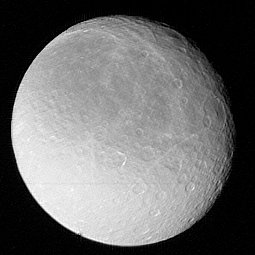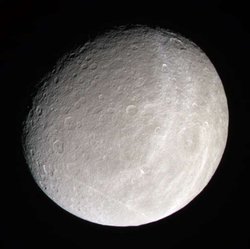Rhea (moon)
|
|

| |||||||
| Discovery | |||||||
|---|---|---|---|---|---|---|---|
| Discovered by | Giovanni Domenico Cassini | ||||||
| Discovered in | December 23, 1672 | ||||||
| Orbital characteristics [1] (http://cfa-www.harvard.edu/iau/NatSats/NaturalSatellites.html) | |||||||
| Semimajor axis | 527,108 km | ||||||
| Eccentricity | 0.0012583 | ||||||
| Revolution period | 4.518212 d | ||||||
| Inclination | 0.345° (to Saturn's equator) | ||||||
| Is a satellite of | Saturn | ||||||
| Physical characteristics | |||||||
| Mean diameter | 1528 km | ||||||
| Surface area | 7,300,000 km2 | ||||||
| Mass | 2.3166×1021 kg | ||||||
| Mean density | 1.24 g/cm3 | ||||||
| Surface gravity | 0.26 m/s2 | ||||||
| Rotation period | 4.518212 d (synchronous) | ||||||
| Axial tilt | zero | ||||||
| Albedo | 0.65 | ||||||
| Surface temp. |
| ||||||
| Atmosphere | none | ||||||
Rhea (ree'-a, Greek Ρέα) is the second largest moon of Saturn and was discovered in 1672 by Giovanni Domenico Cassini.
Name
Rhea is named after the titan Rhea of Greek mythology. It is also designated Saturn V.
Cassini named the four moons he discovered (Tethys, Dione, Rhea and Iapetus) Lodicea Sidera ("the stars of Louis") to honour king Louis XIV. Astronomers fell into the habit of referring to them and Titan as Saturn I through Saturn V. Once Mimas and Enceladus were discovered, in 1789, the numbering scheme was extended to Saturn VII.
The names of all seven satellites of Saturn then known come from John Herschel (son of William Herschel, discoverer of Mimas and Enceladus) in his 1847 publication Results of Astronomical Observations made at the Cape of Good Hope ([2] (http://adsabs.harvard.edu//full/seri/MNRAS/0008//0000042.000.html)), wherein he suggested the names of the Titans, sisters and brothers of Cronos (the Greek Saturn), be used.
Physical characteristics
Rhea is an icy body with a density of about 1,240 kg/m3. This low density indicates that it has a rocky core taking up less than one-third of the moon's mass with the rest composed of water-ice. Rhea's features resemble those of Dione, with dissimilar leading and trailing hemispheres, suggesting similar composition and histories. The temperature on Rhea is 99 K (−174°C) in direct sunlight and between 73 K (−200°C) and 53 K (−220°C) in the shade.Rhea is heavily cratered and has bright wispy markings on its surface. Its surface can be divided into two geologically different areas based on crater density; the first area contains craters which are larger than 40 km in diameter, whereas the second area, in parts of the polar and equatorial regions, has craters under that size. This suggests that a major resurfacing event occurred some time during its formation.
The leading hemisphere is heavily cratered and uniformly bright. As on Callisto, the craters lack the high relief features seen on the Moon and Mercury. On the trailing hemisphere there is a network of bright swaths on a dark background and few visible craters. It is thought that these bright swaths may be material ejected from ice volcanoes early in Rhea's history when it was still liquid inside. However, recent observations of Dione, which has the same bright streaks, shows that these are in fact ice cliffs, and although close-up pictures of Rhea have not yet been taken by the Cassini probe, it is plausible to assume that the bright streaks on Rhea's surface are also ice cliffs.
See also:
The Cassini orbiter is due to perform a flyby of Rhea on November 25, 2005.
External links
- The Planetary Society: Rhea (http://www.planetary.org/saturn/rhea.html)
| Saturn's natural satellites |
|---|
| Janus' group | Mimas | Enceladus | Tethys | Dione | Rhea | Titan | Hyperion | Iapetus | Inuit group | Gallic group | Norse group |
da:Rhea (måne) de:Rhea (Mond) es:Rea (astronomía) fr:Rhéa (lune) it:Rea (astronomia) nl:Rhea (maan) ja:レア (衛星) pl:Rea (księżyc) sk:Rhea (mesiac) zh:土卫五

